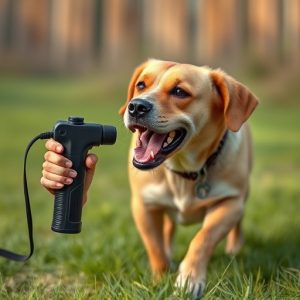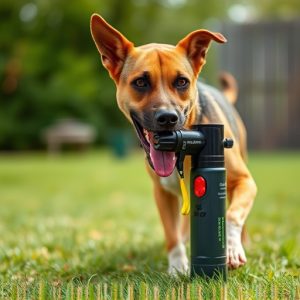Pepper Spray for Dogs: Effective Safety Feature or Risky Choice?
Aggressive dog behavior poses significant risks and recognizing early signs is crucial for canine an…….
Aggressive dog behavior poses significant risks and recognizing early signs is crucial for canine and human safety. Using Safety Features in Canine Repellent ensures minimal harm while addressing aggression effectively. Pepper spray, a potent alternative to conventional deterrents, induces temporary sensory overload in aggressive dogs but carries potential drawbacks for the dog and bystanders. Selecting pet-safe, effective products with key features like spray range and ease of use is vital when using pepper spray as a last resort, balancing its effectiveness against safety risks and ethical considerations while adhering to local laws and instructions.
“Unleashing safety features in canine repellent strategies, this article delves into the use of pepper spray as a deterrent for aggressive dogs. Understanding the root causes and identifying warning signs of dog aggression is pivotal before employing such measures. We explore how pepper spray can effectively deter unwanted behaviors while emphasizing the importance of safety considerations. From effectiveness to potential risks, we guide you in selecting the right pepper spray tailored for dog deterrence, ensuring both animal welfare and public safety.”
- Understanding Aggressive Dog Behavior: Causes and Signs
- The Role of Pepper Spray in Canine Repellent Strategies
- Safety Considerations: Effectiveness and Potential Risks
- Choosing the Right Pepper Spray for Dog Deterrence
Understanding Aggressive Dog Behavior: Causes and Signs
Aggressive dog behavior can stem from a variety of causes, and understanding these root issues is key to addressing them effectively. Factors such as fear, territorial instincts, pain or illness, and lack of socialization can trigger aggressive responses in dogs. Signs of aggression may include growling, snarling, raising of the fur on the back or tail, stiffening of the body, and lunging or biting behaviors. Recognizing these cues early is crucial for both dog safety and the safety of those around them.
When considering canine repellents designed to address aggression, it’s important to look beyond just the active ingredients and delve into the safety features incorporated within. Repellents that combine natural substances with controlled deployment mechanisms offer a balanced approach, ensuring minimal harm while effectively deterring aggressive behavior. These safety features are paramount in mitigating potential risks associated with handling aggressive dogs and promoting peaceful interactions between humans and canines.
The Role of Pepper Spray in Canine Repellent Strategies
In the realm of canine repellent strategies, pepper spray stands out as a powerful and effective tool for managing aggressive dog behavior. As a non-lethal option, it offers a safe alternative to other deterrents, prioritizing the well-being of both pets and their owners while ensuring the safety features in canine repellent are consistently met. This strategic use of pepper spray is particularly beneficial in situations where traditional training methods have proven ineffective or when dealing with unpredictable dogs known for sudden bursts of aggression.
The key to its success lies in the unique chemical composition that triggers a temporary yet intense sensory overload in the target dog. This disruption mimics the effects of a natural predator’s scent, causing the aggressive dog to pause and reevaluate its behavior, thereby providing an opportunity for calmer interactions or escape. With proper application techniques and adherence to safety guidelines, pepper spray can be a game-changer in managing canine aggression, fostering a safer environment for everyone involved.
Safety Considerations: Effectiveness and Potential Risks
When considering pepper spray as a deterrent for aggressive dogs, it’s crucial to weigh its effectiveness against potential risks and safety considerations. While pepper spray can temporarily incapacitate a dog, rendering it less aggressive, it is not without drawbacks. The primary concern lies in the spray’s impact on both the target dog and bystanders—it can cause severe eye irritation, respiratory distress, and even panic attacks in sensitive individuals. Moreover, these sprays might not be suitable for dogs with pre-existing health conditions or allergies.
To ensure safety features in canine repellents, it is essential to opt for products approved by veterinary experts and tested for minimal harm. Users should also familiarize themselves with local laws regarding the use of pepper spray on animals and adhere to instructions carefully. Safety should always be a top priority when considering any method to manage or deter aggressive canine behavior.
Choosing the Right Pepper Spray for Dog Deterrence
When considering pepper spray for aggressive dogs, it’s paramount to select a product tailored to your needs and prioritizing safety features in canine repellent. Look for sprays designed specifically for animal deterrence, as they often incorporate active ingredients that are safe for pets but effective against unwanted behavior. These formulations aim to minimize potential harm while ensuring the spray disrupts the dog’s senses and discourages aggression.
Additionally, consider factors like spray range, visibility, and ease of use. A longer reach allows for safer application from a distance, while visible or glowing sprays can be more effective in low-light conditions. User-friendly features such as ergonomic designs and quick-release mechanisms ensure the spray is readily available when needed, enhancing both safety and effectiveness during interactions with aggressive dogs.
When considering pepper spray as a safety feature in canine repellent strategies, it’s crucial to balance its potential effectiveness with the risks involved. Understanding aggressive dog behavior and choosing the right product are key to ensuring safe and responsible use. By implementing these measures, individuals can better protect themselves and their communities while navigating the complexities of dealing with aggressive dogs.


